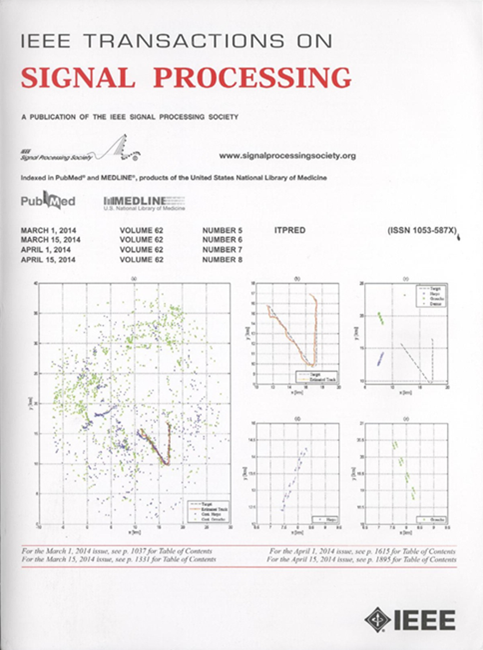用MIMO雷达探测未知反射和呼吸的活人
IF 5.8
2区 工程技术
Q1 ENGINEERING, ELECTRICAL & ELECTRONIC
引用次数: 0
摘要
考虑在监控区域出现一具人体,可能是假的或死亡的。本文的目的是利用多输入多输出(MIMO)雷达来确定人体是否是一个活生生的人。考虑到人体呼吸的振荡特性,建立了活体MIMO雷达接收信号模型,假设胸廓位移、呼吸频率和反射系数是确定但未知的。活人检测问题可表述为二元复合假设检验,为此导出了基于广义似然比检验(GLRT)的检测器。进一步考虑到人类的呼吸可能非常微弱,使得这两种假设太接近而无法很好地区分。针对在两个参数未知的接近假设之间进行选择的问题,提出了MIMO雷达活人检测的广义局部最强大检验(GLMPT)。对基于glrt和基于glmpt的MIMO雷达活人探测器进行了理论性能分析。在给定呼吸频率下,导出了基于glmpt的检测器的检测概率和虚警概率的封闭表达式。通过数值算例对GLRT和基于glmpt的检测器检测呼吸微弱活人的性能进行了评价。研究了系统参数对探测器性能的影响。本文章由计算机程序翻译,如有差异,请以英文原文为准。
Detection of a Living Person With Unknown Reflection and Respiration Using MIMO Radar
Consider the presence of a human body, which could possibly be fake/dead, in the area under monitoring. The purpose of this paper is to determine whether the human body is a living person or not, using multiple-input multiple-output (MIMO) radar. Taking into account the oscillatory characteristics of human respiration, the MIMO radar received signal model for a living person is developed, assuming that the chest displacement, respiration frequency, and reflection coefficients are deterministic but unknown. The living person detection problem can be formulated as a binary composite hypothesis testing, for which the generalized likelihood ratio test (GLRT)-based detector is derived. Further consider that the human respiration could be very weak, making the two hypotheses too close to be well distinguished. Tailored for deciding between two close hypotheses with unknown parameters, the generalized locally most powerful test (GLMPT) for MIMO radar living person detection is proposed. Theoretical performance analyses are provided for both the GLRT-based and GLMPT-based MIMO radar living person detectors. The closed-form expressions for the detection and false alarm probabilities of the GLMPT-based detector are derived for a given respiration frequency. Numerical examples are presented to evaluate the performance of the GLRT and GLMPT-based detectors in detecting living persons with weak respiration. The impacts of system parameters on detector performance are investigated.
求助全文
通过发布文献求助,成功后即可免费获取论文全文。
去求助
来源期刊

IEEE Transactions on Signal Processing
工程技术-工程:电子与电气
CiteScore
11.20
自引率
9.30%
发文量
310
审稿时长
3.0 months
期刊介绍:
The IEEE Transactions on Signal Processing covers novel theory, algorithms, performance analyses and applications of techniques for the processing, understanding, learning, retrieval, mining, and extraction of information from signals. The term “signal” includes, among others, audio, video, speech, image, communication, geophysical, sonar, radar, medical and musical signals. Examples of topics of interest include, but are not limited to, information processing and the theory and application of filtering, coding, transmitting, estimating, detecting, analyzing, recognizing, synthesizing, recording, and reproducing signals.
 求助内容:
求助内容: 应助结果提醒方式:
应助结果提醒方式:


